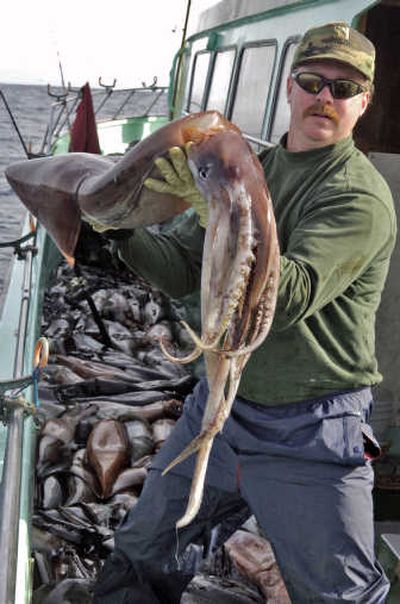Jumbo squid invading Northwest

WASHINGTON – They aren’t your normal calamari. But the jumbo squid now lurking off the Pacific Northwest coast could threaten salmon runs and signal yet another change in the oceans brought on by global warming.
The squid, which can reach seven feet long and weigh up to 110 pounds, are aggressive, thought to hunt in packs and can move at speeds of up to 15 mph. In Mexico, they’re known as diablos rojos, or red devils. They reportedly will attack divers when they feel threatened.
No one knows exactly why they started appearing in increasing numbers off Washington state and Oregon, or how many of them there are, but scientists and commercial fishermen have found them in their nets every year since 2004. One ship trawling for Pacific hake captured an estimated 50 tons of the squid in one net haul. Though they usually prefer deep water, between 1,000 and 1,500 squid washed up on the Long Beach Peninsula in southwest Washington in the fall of 2004.
“This is a new phenomenon,” said Jason Phillips, a faculty research assistant at Oregon State University’s Hatfield Marine Science Center in Newport. A briefing paper from the science center suggested that the jumbo squid may be “well established” in the Pacific Northwest.
Canadian fisheries officials said the jumbo squid were first seen in Northwest waters in the early 1950s.
“But that was a rare event,” said Ken Cooke, the head of applied technology for the Canadian Department of Fisheries and Oceans in Nanaimo, B.C. “It’s not rare anymore. They were always thought to be a transient visitor; now it appears they are resident.”
Also known as the Humboldt squid, they’ve typically been found off the coasts of Mexico, Central America and Peru. Near the town of Santa Rosalia, Mexico, several years ago, an estimated 10 million squid were living in a 25-square-mile area.
In the late 1990s, they appeared in increasing numbers off the central California coast around Monterey Bay. By 2005, jumbo squid were found as far north as Sitka, Alaska.
“There is no question they have moved north and in pretty large numbers off Washington state and Oregon,” said John Field, a fisheries biologist with the National Oceanic and Atmospheric Administration based in Santa Cruz, Calif., who’s studied them.
At the same time that the jumbo squid were moving north, they also were moving south along the South American coast. Chilean fishermen used to catch none. Now they’re catching 200,000 tons a year, mostly for export to Asia, Field said.
“The fact this is happening in both hemispheres could be a sign it is tied in with global warming,” Field said. “We are trying to piece this all together.”
Others have suggested that the squid have been able to expand their range because of over-fishing of its natural predators, including tuna, sharks and swordfish. At the same time, though, the population of another of the squid’s predators, sperm whales, has roughly doubled off the West Coast.
The mystery grows even more complicated when scientists start talking about a huge bubble of low-oxygen water off the west coasts of North and South America that seems to be expanding, perhaps because of higher ocean temperatures.
Jumbo squid thrive in that low-oxygen zone. Generally warmer ocean temperatures along the Northwest coast also could be a factor, though jumbo squid can live in colder waters as well.
“They are the poster child in how to succeed in a changing world,” said William Gilly, a Stanford University biology professor.
Jumbo squid are voracious predators that dine on krill, lantern fish, shrimp, sardines, rockfish and other squid. They’re cannibalistic. Sharp, barbed suckers on their tentacles snare their quarry and drag it to their mouths, where it’s torn to shreds by baseball-size beaks.
“They are amazing predators,” Cooke said. “They will eat anything and continuously. They don’t have an off-on switch.”
Cooke said jumbo squid can grow up to an inch or so a day, but that their life span is no more than two years.
The squid’s favorite food could be Pacific hake, a whitefish often used in fish sticks. The Pacific hake fishery is the biggest on the West Coast, and its populations have been declining as the squids’ range has grown.
“Major fisheries could be affected,” said Louis Zeidberg, a Stanford University researcher. “They can interrupt the normal migration pattern of hake.”
Scientists aren’t sure what impact jumbo squid have had or may have on the dwindling salmon runs of the Pacific Northwest. Zeidberg said there’s anecdotal evidence that the squid have been eating salmon. Field said he’s never found salmon remains in the stomachs of the more than 500 squid he’s dissected.
“The bottom line is we don’t know if they are a threat to salmon, but it is certainly plausible,” Gilly said.